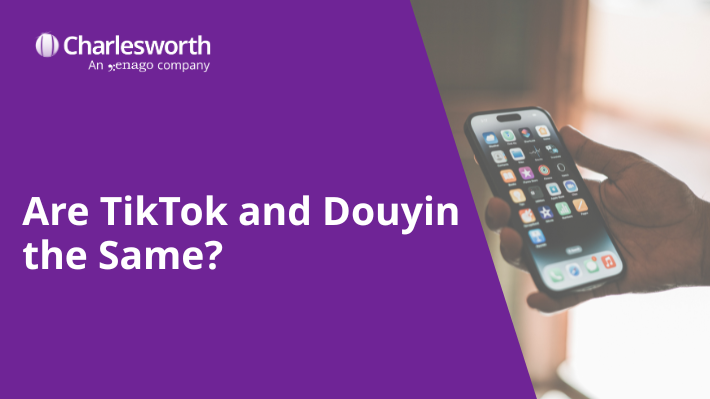Are TikTok and Douyin the Same? Understanding Both Platforms

In the world of social media, TikTok and Douyin have garnered massive attention, with millions of users engaging with short-form video content daily. While both platforms share the same parent company, ByteDance, and have a similar format, they are actually distinct platforms, tailored for two very different markets. TikTok is the app that has taken the global stage by storm, while Douyin operates exclusively in China.
What Is TikTok?
TikTok is a social media platform that allows users to create and share short videos, typically set to music. Launched globally in 2016, TikTok quickly became a cultural phenomenon, particularly among younger generations. The app’s algorithm prioritises content discovery, making it easy for users to find and interact with videos that align with their interests. The main selling point of TikTok is its highly engaging and interactive user experience, which encourages creativity, trends, and viral challenges.
With over 1 billion active users as of 2023, TikTok has become a dominant force in the social media landscape, particularly in markets outside China, including the United States, Europe, and South East Asia.
What Is Douyin?
Douyin, the Chinese counterpart to TikTok, was launched in 2016 by ByteDance, the same company behind TikTok. Douyin operates strictly within mainland China, where it has achieved even greater success than its international counterpart. By 2023, Douyin had over 600 million daily active users. Douyin follows a similar short-form video format as TikTok, but it is designed specifically to cater to Chinese internet users, with a localised experience that incorporates different cultural, legal, and business considerations compared to TikTok.
While TikTok and Douyin share a core concept of video content creation, Douyin offers a broader suite of services, integrating e-commerce, online payment systems, and other features that are tailored for the Chinese market.
Key Similarities Between TikTok and Douyin
Despite operating in different regions, TikTok and Douyin share a significant number of similarities. Both platforms are built around the concept of short-form video content, with the goal of allowing users to create and share engaging videos.
- Video Creation Tools: Both TikTok and Douyin offer similar video editing features, including filters, effects, speed adjustments, and a wide range of music tracks. These features allow users to create dynamic and engaging content easily.
- Algorithm-Based Content Discovery: One of the core features of both platforms is their content discovery algorithm. The For You Page (FYP) on TikTok and its equivalent on Douyin both use an AI-driven recommendation system, suggesting videos based on user interests, past interactions, and trending content.
- User Interaction: Both platforms drive high engagement through likes, comments, shares, and duets. Douyin: 600M+ daily active users (2023), with users spending 52 minutes/day on average; 85% of users interact daily (e.g., 1.2M likes/comments per trending video). Case: TechSpark saw 150% sales growth via Douyin livestream shopping. TikTok: Users spend 95 minutes/day globally, 75% engage daily. Example: UrbanThread gained 120% website traffic from a viral hashtag challenge. Douyin campaigns yield 30% higher ROI (e.g., Floral Beauty achieved 200% ROI). TikTok excels in brand awareness via viral trends.
- Viral Culture: Both platforms thrive on viral trends. Hashtag challenges, viral memes, and trending songs form the backbone of content on both TikTok and Douyin. The rapid spread of trends is one of the main attractions for users of both platforms.
Key Differences Between TikTok and Douyin
While TikTok and Douyin share many similarities, they are distinct in several important ways. These differences primarily arise due to the platforms being designed for different markets, each with its own needs and regulations.
- Market and Accessibility:
- TikTok is available in over 150 countries, including the United States, the UK, and much of Europe and Asia. The platform supports multiple languages, catering to a global audience.
- Douyin, however, is exclusively available in mainland China. The app is not accessible outside of China, and its content is governed by Chinese laws and regulations, including censorship rules.
- Content Moderation and Censorship:
- Douyin is subject to strict content moderation rules set by the Chinese government. Content that is deemed inappropriate or politically sensitive, such as material related to anti-government sentiments or foreign political issues, is censored. The platform also has guidelines around promoting traditional Chinese values, which are in line with China’s broader internet censorship policies.
- TikTok, on the other hand, follows the content moderation guidelines set by its international markets, which may vary by country. While TikTok also removes harmful or inappropriate content, the platform has fewer constraints on political content compared to Douyin.
- E-commerce Integration:
- Douyin has Localised Ecosystem: Fully integrated with China’s digital infrastructure, including built-in payment systems (Alipay, WeChat Pay) and live-stream shopping. Similar to Baidu’s seamless Alipay integration in search ads, Douyin shortens the conversion path by allowing users to purchase directly within videos; Social Commerce Model: Brands should adopt a “video-to-purchase” strategy, leveraging short videos to showcase products and guide users to in-app stores. For example, during a 2023 campaign, SportLife used 15-second tutorials to drive 40% of viewers to product pages within 10 seconds.
- TikTok has been testing its own e-commerce features in various markets, including TikTok Shopping, which allows creators and brands to promote products. However, TikTok’s e-commerce features are not as deeply integrated as Douyin’s, especially in terms of direct payment systems and shopping experiences within the app.
- Advertising and Monetisation:
- Douyin offers a more sophisticated range of advertising options, such as in-feed ads, brand takeovers, and interactive ads. Additionally, the platform’s integration with e-commerce allows brands to directly sell products through ads. Influencers in China often monetise their content through brand collaborations, live-streaming, and product promotions.
- TikTok also offers in-feed ads, branded hashtag challenges, and live-streaming features for creators, but its advertising model is still evolving. While monetisation opportunities for creators exist, TikTok’s integration with e-commerce has yet to match the seamless experience available on Douyin.
- User Demographics:
- TikTok has a predominantly younger user base globally, with a strong following among Gen Z (ages 16-24). However, its reach is expanding to older age groups as well, with users increasingly spanning a wide demographic.
- While Douyin attracts younger users, 40% of its active users are aged 35+ (2023 data). Older generations engage heavily with content on family life, health tips, and practical skills (e.g., cooking tutorials, financial planning). It also prioritises “practical-driven” videos, such as product demos in real-life scenarios (e.g., HomeCare boosted sales by 60% with short videos teaching elderly users to use smart appliances).
How Brands Can Leverage TikTok and Douyin
For international brands looking to enter the Chinese market, Douyin offers an established and highly effective platform to target Chinese consumers. Estée Lauder: Achieved $15M in sales during a 2023 Singles’ Day livestream by collaborating with top influencers to demo products in real-time. Over 2 million viewers engaged, with 70% purchases made via in-app links; Maybelline: Partnered with Douyin beauty creators for a “#LipArtChallenge”, generating 500K user-generated videos and a 300% surge in lipstick sales within a week. Brands can take advantage of Douyin’s e-commerce capabilities, influencer marketing, and targeted advertising to drive sales and build brand recognition in China.
Meanwhile, TikTok remains an excellent platform for global marketing, enabling brands to reach an international audience, engage with younger consumers, and leverage viral trends for greater brand awareness. With TikTok’s continued global expansion, it provides a great opportunity for brands to connect with consumers worldwide.
Final Thoughts
While TikTok and Douyin share the same parent company and many similarities in their core functions, they are tailored to different markets, with distinct regulations, user behaviours, and features. Douyin’s robust e-commerce integration and stricter content control make it highly suitable for Chinese users, while TikTok’s global reach and content flexibility make it the preferred platform for international brands looking to connect with younger audiences worldwide.
As a brand, understanding these differences and tailoring your strategy for each platform is key. If you want to expand into China, Douyin should be a key part of your digital strategy. However, for global reach, TikTok remains a powerful tool to capture the attention of users across multiple countries and regions. Ready to conquer China’s dynamic market through Douyin? Consult our experts today!


